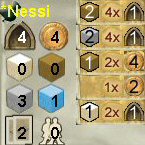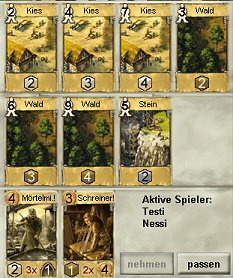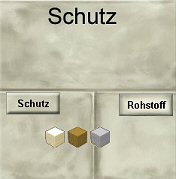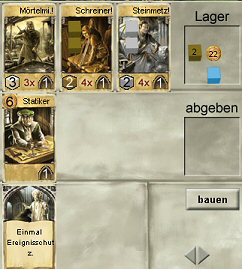Säulen der Erde
SaeulenDerErde (Originalregel)
Starting The Game
With /join 2-4 players can join the game. With /start the game begins. alternative, you can use the Game Tool!
Object of the Game
Pillars of the Earth is a strategic board game with extensive Rules. Here we provide an abridged listing of the online game. There is no claim to completeness of the rules. It is best to download the rules from here (German).
Each player controls a group of craftsmen, who aspire to build the largest cathedral of the Middle Ages. They must distribute their workers effectively, enlist qualified craftsmen, employ their master masons diligently and so request aid from the clergy. Those who put sufficient work into the building of their cathedral, will be able to earn the most victory points and win the game.
Game board

- Bishop's Seat
- Wool Mill
- Kingsbridge
- Kingsbridge Priory
- Forest/quarry/gravel pit
- King's yard
- Shield
- Shiring Castle
- Kingsbridge Builders Warehouse
- Cathedral
- Status Indicator
- Build Master's Cost Clock
- Player Dashboard

In the right helped of the screen is the individual player's scoreboard showing your current items and status. Click on your area to open your craftsman window.
In the left half of the craftsman window is the player's name and if you are the starting player, a black pouch (starting symbol). Beneath this, in the archway your current victory points are shown, and to the right of it your current gold. Below this your raw meterials are listed, sand (white), wood (brown), stone (grey) and metal (blue). At the bottom the number of advantage cards and the number of existing workers are shown.
Flow of the game
The game runs over six rounds, each consisting of three phases.
Each player receives at the beginning:
- three master masons
- twentieth
- two victory points
- three craftsmen (mortar mixer, stone-cutter, carpenter)
- The starting player receives 20 gold, and each subsequent player one more gold.
Phase I
In the first phase craftsmen and building material cards are selected.

Each round, two craftsmen and seven building material cards are made available.
You must have the number of available workers (as shown in the top left of a card) to be able to pick that card up. If you do not have sufficient workers, you must pass.
If you want to take one of the two the craftsman cards, you have to be distract to pay the demanded price in gold (top left on the card). Since the maximun craftsmen you can have is 5 , you get a window prompt when you buy the sixth, asking you to give up one of your existing craftsman; this may be the one you just bought.
The active player selects a card and confirms his choice by clicking on the "Take" button. The other players follow in turn. If you wish no further cards then you can click on "Passenger". All craftsmen, who were not selected, are moved to the yarn spinners, where they will provide later income. Phase I ends when all cards are taken or all players have passed.
Phase II
In the second phase, the three master masons of each player are distributed. You do this by drag and drop. The starting player may reject once per round a building master. this comes then back to the selection and can be pulled at a later time again.
A moved master mason may be used by his owner at the following places on the board:
- Bishop's House (protection from an event)
- Kingsbridge (take an advantage card)
- Kingsbridge Priory (victory points)
- King's yard (tax exemption/metal)
- Shiring (enlist craftsman)
- Shiring Castle (two workers for the next round)
- Kingsbridge Builders Warehouse
- Cathedral (starting player next round)

Each possible location is marked by a button.
The costs of bringing a master builder into the game depend on the time it is done:

Placing the first master mason (if it was not rejected by the starting player and assured) costs seven gold. If you don't wish to pay this (or cannot), you may place it next to the 7 marker. In the same way, the next master mason may be placed for 6 gold or left next to this field, then 5 and so on.
Once all the 8 spaces have been used (either by playing or placing next to), masterany masons that were parked free of charge, may now be placed for free, starting with the highest value field.
Phase III
In the third phase the actions of the game board are resolved as follows:
Events
At the beginning of the third phase an event card is uncovered. Events always apply to every player. There are some positive and some negative event cards. Only the player, who has placed one of his master masons at the Bishop's Seat or who owns an appropriate advantage card, can protect themselves against an event (see next item).
Bishop's Seat
The player, who places a master mason at the bishop's house, can protect himself in this round from either a (negative) event (see previous point) or tilting, can take any raw material from the Builders Warehouse.

In this window you can select "Protection" or "Raw material". If you want the raw material, just click on the material type that you want. As long as you haven't clicked on ‐OK, you can still change your mind.
Wool Mill
You receive 1 gold for each worker you placed in the wool mill at the end of phase I. However, a player can never have no more than 30 gold. Any extra is removed.
Kingsbridge
In Kingsbridge two advantage cards are available. Move your master mason under the card that you wish to select.
There are generally three kinds of advantage cards:

These cards apply up to the end of the game.

These cards can be used only once. The owner may determine when to play it. Once used it is discarded.

These cards apply Member and immediately come into play.
Note: Before the last (sixth) round, the last two cards are always immediately get 1 metal and immediately get 1 stone and 1 wood.
Priory
If you place your master mason on the 1st field at the priory, you receive 2 victory points. If you place your master mason on the 2nd field at the priory, you receive 1 victory point.
Builders Warehouse
Each player receives material according to the building material cards chosen during phase I.
King's yard
If the king's yard is evaluated, the tax for this round is determined. The amount of tax can be 2/3/4/5 gold, but 3 and 4 is twice as likely as 2 and 5.
Players, who place a master mason in the king's yard, pay no taxes this round. The player, who places his master mason first at the king's yardhe has to have occupied the single master mason spot) receives an additional metal for his loyalty to the king.
Shield
In Shiring, the two craftsmen are now added to the player who placed here. Contrary to phase I you do Not applicable have to pay for these craftsmen.
Shiring Castle
The player gets 2 extra (grey) workers. During the next round he can place them - like his own - either on the raw material spots or in the wool mill. At the end of the (next) round he has to give them up again.
Kingsbridge Builders Warehouse
You can only use the Builders Warehouse, provided you have placed a master mason there. The players can trade, change (in the order of placement of master masons)from left to right) as necesseary.
The following applies when trading at the Builders Warehouse:
- For each action you may buy or sell one child of material
- Selling you may sell as manyraw materials as desired.
- Buying you may buy as many raw materials, as are still available in the warehouse (four max at the beginning) provided you have enough gold.
- Metal can only be soldiers
- The cost/value for sand is 2 gp, wood is 3 gp, stone is 4 gp and metal is 5 gp.

You first decide whether to "buy" or "sell". Then click on the desired material type, select the quantity that you would like to buy/sell and then complete the transaction with the "execute" button. If you have finished with here use the button "leave" to complete.
Note: It is not permitted to first buy a type of material and then sell it in the same round (to withhold a specific material type from another player)!
Cathedral
The player, who places a master mason in the cathedral, becomes the starting player in the next round. If there are no master masons there, the starting player will be the next player in a detection direction from this round.
Now everyone can build in the cathedral according to the craftsmen and raw materials that they have.

Here are the details of each of the craftsmen cards:
- Types of raw material needed
- The maximum number of times he can process raw materials in each round.
- The for using benefit the craftsman (gold or victory points).
In the example the "Steinmetz" (stone-cutter) could convert 2 stones 4 times and receive 1 victory point each time (he could make a maximum of eight stones with four victory points).

Each players can decide which craftsman process which raw materials, in order to victory points or gold. Drag the appropriate raw materials from your pile on to the desired card. In this example the "Schreiner" (carpenter) already has 2 wood and the "Steinmetz" (stone cutter) already has 2 stones. The player can still use the remaining wood with the carpenter.

The craftsmen work in series, one after the other, so that for example you can receive gold for the toolmaker (toolmaker) and then use metal with another craftsman. The goldsmith (Goldschmied) can work the gold obtained by the toolmaker and the carpenter. In this case the gold assessment is shown twice: the expected gold on hand and the current income through those craftsmen (shown in brackets).
At the end of the round you can keep no more than 5 materials! If you have more than five, you must dispose of the surplus by draging it to the "delive" box
Once you have dispositioned your excess material, you confirm this by clicking –bauDEN (build).
Note: If you click on ‐bau and you get a warning sound , you should check the following:
- no more than 5 materials in your store?
- The correct raw materials on the craftsmen?
- many raw materials on a craftsman (consider the max limit)?
End of the Game
The game ends after the sixth round, when the cathedral is completed. The winner is the player with most victory points. With a draw, the player with the highest gold, wins.
Game Options
dm
Each player places only two master builders in the bag. Then Phase II is played normally until the two master builders from each player have been placed on a vacant space i.e. until the bag and the cost of track are empty. Then each player can place his third master builder free. This is done in reverse order of the person who placed the first master builder. This means that the player who was last to place, can now place his third master builder. The other players play in this order until the player who placed first. They then place their third master builder.
Deviation: If the event card which states that each player can only place two master builders in the next round; is turned over, then the second master builder of any player who does not have protection from this event, will not be used. The order for placing the 3rd master builder is described above.
References
Special function craftsman
The three craftsman which you receive at the beginning of the game (the mortar mixer, carpenter and stone-cutter - each marked by an exclamation mark after their name), have special functions, which can have an effect on the game:
- without the Mortar mixer (mortar mixer) none of your Maurer (brick layers) can build and score victory points!
- without the Stone chip (stone cutter) you can not sell stones!
- without the Carpenter (carpenter) you can not buy wood!
You should consider carefully, which craftsmen to give up during the game.
Event Card - Craftsman Capacity Increase

There is one event card in the game where the players can increase the capacity for one of their own craftsman by one item. You will see a hammer symbol over one of your craftsmen. Drag and drop it to the craftsman of your choice, the one which you wish to increase their output.
You should be aware that you cannot increase neither the bell caster nor organ farmer. In addition, toolmakers and stress analysts do not have a capacity, but bring a firm yield. They cannot be increased therefore likewise.
Inability to pay
During the game it can happen that a player becomes insolvent (king's tax or event). In that case the player pays as long as he has enough gold. The rest is paid by victory points in a 1:2 scale (one victory point is turned into two gold). This calculation is rounded down, so 3 gold only costs 1 victory point.
FAQ
- I cannot pick up a building material card - > do you have sufficient workers available?
- I cannot pick up a craftsman card - > do you have sufficient gold?
- I cannot place a master mason - > do you have sufficient gold?
- I cannot sell a certain raw material in the warehouse - > have you already bought this type of material this round?
- I didn't get enough money when I built/sold - > Have you reached a limit of 30 gold?
- How can my opponent have six craftsmen? - > Does he possess the advantage card 6 craftsmen
Order of the workers
| Round | Worker (Handwerker) | RESOURCES | Capacity | Output | |||||
|---|---|---|---|---|---|---|---|---|---|
| Sand | Wood | Stone | Gold | Metal | Victory Points | Gold | |||
| 1 | Bricklayer (Maurer) | 0 | 0 | 1 | 0 | 0 | 2 | 1 | 0 |
| Mortar mixer (Mortar Mixer) | 2 | 0 | 0 | 0 | 0 | 3 | 1 | 0 | |
| Carpenter (Carpenter) | 0 | 1 | 0 | 0 | 0 | 2 | 0 | 4 | |
| Toolmaker (Tool Maker) | 0 | 0 | 0 | 0 | (1) | (1) | 0 | 2 | |
| 2 | Bricklayer (Maurer) | 0 | 0 | 1 | 0 | 0 | 3 | 1 | 0 |
| Statiker (Stress Analyst) | 0 | 0 | 0 | 0 | 0 | (1) | 1 | 0 | |
| Potter (Potter) | 1 | 0 | 0 | 0 | 0 | 2 | 1 | 0 | |
| Zimmermann (Finish Joiner) | 0 | 1 | 0 | 0 | 0 | 2 | 1 | 0 | |
| 3 | Sculptor | 0 | 0 | 1 | 0 | 0 | 1 | 2 | 0 |
| Bricklayer (Maurer) | 0 | 0 | 1 | 0 | 0 | 4 | 1 | 0 | |
| Potter (Potter) | 1 | 0 | 0 | 0 | 0 | 3 | 1 | 0 | |
| Zimmermann (Finish Joiner) | 0 | 1 | 0 | 0 | 0 | 3 | 1 | 0 | |
| 4 | Sculptor | 0 | 0 | 1 | 0 | 0 | 2 | 2 | 0 |
| Glass Blower | 1 | 0 | 0 | 0 | 1 | 1 | 3 | 0 | |
| Bricklayer (Maurer) | 0 | 0 | 1 | 0 | 0 | 5 | 1 | 0 | |
| Zimmermann (Finish Joiner) | 0 | 1 | 0 | 0 | 0 | 4 | 1 | 0 | |
| 5 | Sculptor | 0 | 0 | 1 | 0 | 0 | 3 | 2 | 0 |
| Glass Blower | 1 | 0 | 0 | 0 | 1 | 2 | 3 | 0 | |
| Goldsmith | 0 | 0 | 0 | 0 | 3 | 6 | 1 | 0 | |
| Zimmermann (Finish Joiner) | 0 | 1 | 0 | 0 | 0 | 5 | 1 | 0 | |
| 6 | Sculptor | 0 | 0 | 1 | 0 | 0 | 4 | 2 | 0 |
| Clock Maker | 0 | 0 | 0 | 0 | 1 | 2 | 4 | 0 | |
| Goldsmith | 0 | 0 | 0 | 3 | 0 | 8 | 1 | 0 | |
| Organ Maker (Organ Maker) | 0 | 1 | 0 | 0 | 1 | 1 | 6 | 0 | |

